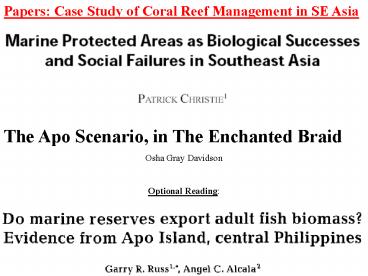GOALS: - PowerPoint PPT Presentation
1 / 50
Title: GOALS:
1
Papers Case Study of Coral Reef Management in SE
Asia
The Apo Scenario, in The Enchanted Braid Osha
Gray Davidson Optional Reading
2
- PHILIPPINE CORAL REEFS
- Ecological Catastrophe Problem
- 4.3 or 1,161 sq. km. of the Philippines
sprawling 27,000 sq. km. of coral reefs are in
good condition today. - 25,839 sq. km. or 95.7 of Philippine coral
reefs are in a very bad state.
3
- Causes of Destruction
- Destructive fishing methods
- Cyanide fishing
- Muro-Ami (drive-in technique) destroys large
sections of coral reefs because the weights used
to keep the scare lines vertical end up
breaking corals.
4
4. Trawling 5. Malthusian overfishing Occurs
when poor fishermen faced with declining catches
and lacking any other alternative, initiate
wholesale resource destruction in their effort to
maintain their incomes. Examples include
blasting and cyanide fishing. 6. Other forms of
destruction pollution, sedimentation, typhoons,
global warming, collection and dredging.
5
Failed methods
- Marine Protected Areas have biological successes
but ignore social complexities this prevents
long term success in improving coral reefs. - Comparative analysis was taken in 4 MPAs in
Southeast Asia San Salvador Island, Twin Rocks,
Balicasag Island, and Bunaken National Park.
6
(No Transcript)
7
- All locations experienced biological success more
consistently than social success. The initially
successful management process deteriorated over
time due to the lack of consistent and long term
support of governmental agencies and NGOs that
initially implemented coral reef restoration
programs.
8
- Bunaken National Park The management and
enforcement did not take into consideration the
interests of many local fishing communities. - Island communities which were initially unified
behind the MPA are now divided.
9
What Long-term Successes Exist?
- APO ISLAND (Biological Social) a ray of hope
in an otherwise bleak situation, Davidson, pg
155. - SAN SALVADOR (Biological only)
- TWIN ROCKS (Biological only)
- BALICASAG ISLAND (Biological only)
- BUNAKEN NATIONAL PARK (Biological only)
10
(No Transcript)
11
(No Transcript)
12
Philippine Islands
Apo Island
13
Apo Island
Apo Island is a small volcanic hump rising five
miles off the southern tip of the larger island
Negros. The island has an unique protected reef
reserve began as a project of Silliaman
University in 1985.
14
Apo Island
15
Apo Island
16
GOALS
- Increase Biodiversity
- protect reefs native species diversity
- Increase Fisheries
- large size fish population s
- Increase Local Job Opportunities
- jobs other than fishing
- education of public/ tourists
- community support of protected areas
17
Biological GOALS Davidson sponges the size of
this desk (6x3)
18
GOAL Increase Biodiversity protect reefs
native species diversity Palawan Starfish
19
Apo Island Marine sanctuary and house reef are
known for the enormous variety of hard- and soft
corals.
20
Table coral Apo island
21
Turtle Apo Island
22
Whale shark Apo Island
23
(No Transcript)
24
(No Transcript)
25
- GOAL
- Increase Fisheries
- large size fish populations
26
(No Transcript)
27
(No Transcript)
28
Apo Island
29
(No Transcript)
30
Butterfish Apo Island
31
(No Transcript)
32
(No Transcript)
33
Clownfish-City, Apo Island
34
Apo Island
35
Why did Apo Island work?
- Small size of island reef (lt200 acres)
- Small local fishing community (couple hundred
people) - No sediment, nutrient loading, pollution issues
36
What Alternatives Exist?
- Local (poor?) fishermen need food and income at
a sustaining level - Trawlers (richer?) pay debts on boat, pay
workers, provide profit
37
Proposed Solutions
- Broaden Stakeholder involvement to include all
stakeholders and not marginalize the poor
fishers. - Sharing of Economic Benefits Sharing profits
with the local community from all activities - Conflict Resolution Mechanisms Long-term means
to resolve stakeholder disagreements
38
Proposed Solutions
Broaden Stakeholder involvement to include all
stakeholders and not marginalize the poor fishers.
Apo Island kids
39
(No Transcript)
40
- Proposed Solution
- Sharing of Economic Benefits
- Sharing profits with the local community from all
activities - View of Negros Market, Philippines
41
Apo Island
42
Earthwatch Eco Tours
- What about local customs?Many projects work in
remote communities, some far off the beaten
track. - Earthwatch stresses the need for responsible
behavior and common courtesy when traveling in
these areas. - Learn to respect local customs. Involvement in
other cultures is one of the privileges of
joining an Earthwatch expedition.
43
Philippine Eco- tourism
44
Proposed Solution
Conflict Resolution Mechanisms Resolve
Stakeholder Disagreements Long-Term
45
Proposed Solutions
- Davidson Get scientists policy makers alike
to wake up to the complex realities involved in
tackling the life-and-death issue of Malthusian
over fishing - Davidson Scientists managers must break out
of their narrow boxes grasp the basic
principles .. Outside the hard sciences. - Davidson (The) widespread problem of science
illiteracy among the public.. - Davidson massive changes in politics
economics. Coral reef people alone cant do
this.
46
How Can We (as Students, Consumers) Help?
- Write letters to Governments, NGOs, other?
- Volunteer Peace corps, NGOs, other?
- Buy Fair- trade/ organic products
- Boycott certain products?
47
(No Transcript)
48
How can long-term success be assured to allow
governments NGOs to leave (so to invest help
elsewhere) ?
- Unless the fisher folk are empowered in the
truest sense and given alternative livelihoods,
then the remaining resources will not be
preserved and sustained. (Sotto in Davidson, pg
156).
49
APO ISLAND
- After years of Muro-ami, cyanide and blast
fishing, with destruction of reefs declining
fish catches - 1982 Marine reserve established (8 of reef)
- 1982 85 No changes (Enforcement issues?)
- 1985 86 Minor increases in reserve s
diversity - 1988 3.5 times increase in reserve pop s
- 1993 8 times increases in reserve pop s
- 1991-93 SPILLOVER ? Increased s outside of
reserve - All 21 fishermen surveyed reports catches 2X that
of 85
50
(No Transcript)































